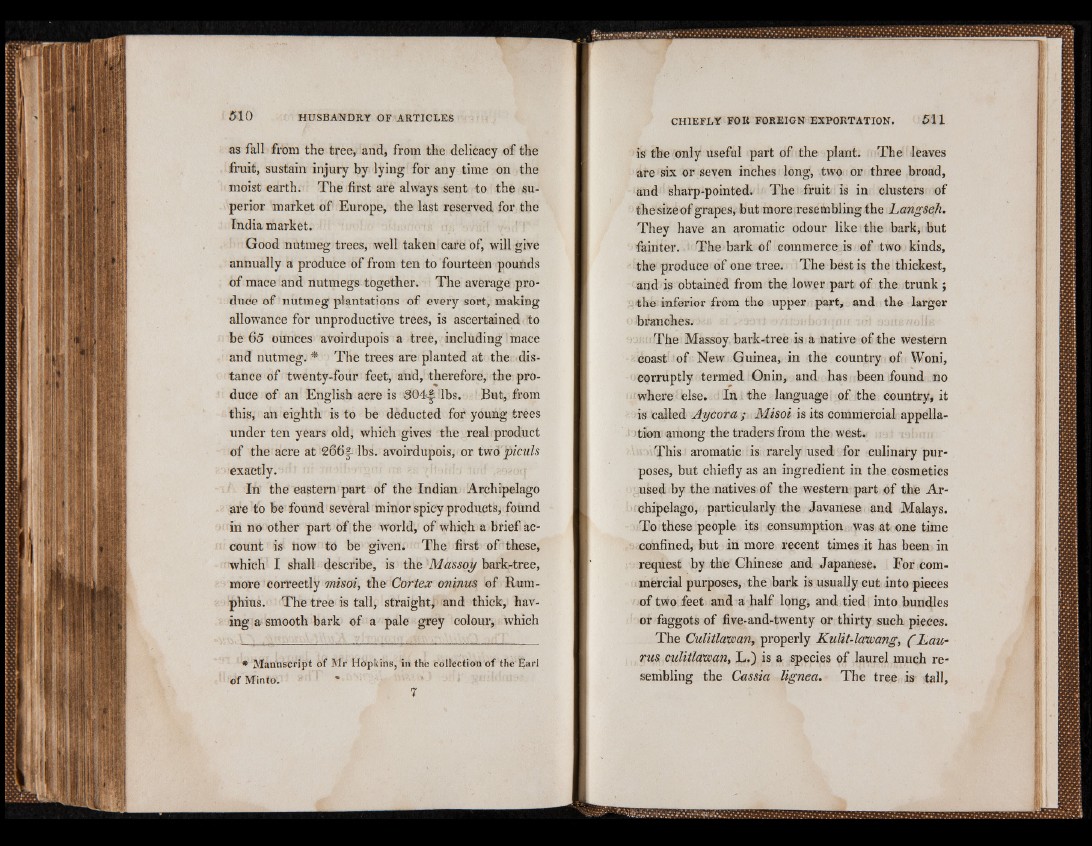
as fall from the tree, and, from the delicacy of the
fruit, sustain injury by lying for any time on the
moist earth. The first are always sent to the superior
market of Europe, the last reserved for the
India market.
Good nutmeg trees, well taken care of, will give
annually a produce of from ten to fourteen pounds
of mace and nutmegs together. The average produce
of nutmeg plantations of every sort, making
allowance for unproductive trees, is ascertained to
be 65 ounces avoirdupois a tree, including mace
and nutmeg. * The trees are planted at the distance
of twenty-four feet, and, therefore, the produce
of an English acre is S04|- lbs. But, from
this, an eighth is to be deducted for young trees
under ten years old, which gives the real product
of the acre at 266§- lbs. avoirdupois, or two piculs
exactly.
In the eastern part of the Indian Archipelago
are to be found several minor spicy products^ found
in no other part of the world, of which a brief account
is now to be given. The first of these,
which I shall describe, is the Massoy bark-tree,
more correctly misoi, the Cortes oninus of Rum-
phius. The tree is tall, straight, and thick, having
a smooth bark of a pale grey colour, which
* MannsCript of Mr Hopkins, in the collection of the iiarl
of Minto. ' *
7
is the only useful part of the plant. The leaves
are six or seven inches long, two or three broad,
and sharp-pointed. The fruit is in clusters of
the size of grapes, but more resembling the Langseh.
They have an aromatic odour like the bark, but
fainter. The bark of commerce is of two kinds,
the produce of one tree. The best is the thickest,
and is obtained from the lower part of the trunk ;
the inferior from the upper part, and the larger
branches.
The Massoy bark-tree is a native of the western
coast of New Guinea, in the country of Woni,
corruptly termed Onin, and has been found no
where else. In the language of the country, it
is called Aycora ; Misoi is its commercial appellation
among the traders from the west.
This aromatic is rarely used for culinary purposes,
but chiefly as an ingredient in the cosmetics
used by the natives of the western part of the Archipelago,
particularly the Javanese and Malays.
To these people its consumption was at one time
confined^ but in more recent times it has been in
request by the Chinese and Japanese. For commercial
purposes, the bark is usually cut into pieces
of two feet and a half long, and tied into bundles
or faggots of five-and-twenty or thirty such pieces.
The Culitlawan, properly Kulit-lawang, (JLau-
rus culitlawan, L.) is a species of laurel much resembling
the Cassia lignea. The tree is tall,